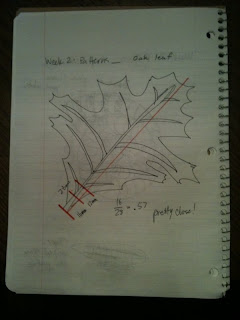Have you ever heard of the Fibonacci Sequence? 1+1+2+3+5+8...etc. It's a mathematical pattern where the combination of the two previous numbers equals the next number in the sequence. For example, take 2 and 3, add them together and you have 5. It's a strange pattern that can be found all around us. We use it in computer software and it exists in the arrangement of the keys on a piano. It's is used in architecture, dating back as far as the Great Pyramids.
And it may be one of our oldest forms of Biomimicry...
In our lecture this week, we learned about how this mathematical pattern exists abundantly in nature. To explore the veracity of these claims, I set out on a simple 30 minute walk to find my own examples of the Fibonacci pattern within biology. I found more than I had expected.
Leaves are like snowflakes, no two are alike. There is however a pattern that exists from species to species that explains why many leaves are similar in shape - it's called branching and it is a wonderful example of the Fibonacci pattern in action. Here's a picture of an Oak leaf that I drew during my walk:

The interesting thing about the Fibonacci Sequence is that after the 12th number any number divided by the number before it equals approximately 1.608. The base of the leaf to the first branch (in my picture) was 16mm. The base of the leaf to the second branch was 28mm. 28/16 is 1.75. That's pretty close to 1.608, and keep in mind that this was a rough sketch of the real thing!
After digging under some leaves I encountered an old snail shell. Snail shells are another incredible example of the pattern in action. Here's a picture of the sketch that I created next to a graphic representation of the Fibonacci Sequence:

Isn't that incredible? As chaotic as nature seems, patterns exist. Some of these patterns are obvious, and others we have yet to discover.
One pattern I know very well is the seasons. As I walked through my habitat (Hidden Beach) I encountered a downed tree. The last time I was near that tree I was playing in the snow with my girlfriend. Now, the snow is gone and the ice on the lake is melting. I noticed new growth, where the ground was not covered in dead leaves:


Spring has returned, and so too have the birds to share their patterned songs with me. The robin with its dee-dooo, dee-dooo and another unknown bird with its boo-keer-tee, boo-keer-tee. The more I paid attention the more I realized that recognizing patterns is key to understanding nature.
Some believe that sequences and numbers are ugly, but I disagree. Patterns are beautiful, so much so that I see it fitting the frequency at which nature is used as the subject in a piece of art.
No comments:
Post a Comment